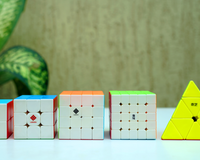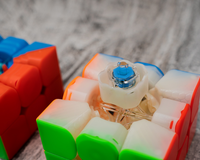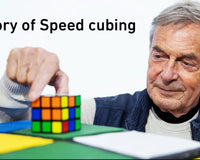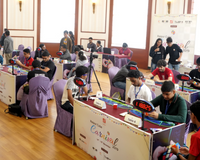Are you looking to learn a new method on an event? Wondering what you should set your mind to and practice? Look no further! This blog answers some questions about how some methods are compared to other for certain events, and how the split breakdown should look for each of them. The event covered here is going to be 4x4 for now, but can branch out further if this blog helps a lot of people!

Checkout our collection of various 4x4 speedcubes now!
4x4:
The two main methods that speedcubers use on 4x4 is Yau and Reduction. Both of these methods come with their pros and cons, and Yau is generally considered the more advanced method and is more widely used. However, the swap from Reduction which is generally considered a beginners method to Yau is very jarring and can often drop times and demotivate people. Right now, what we will be doing is looking at some well known milestones for 4x4 and looking at the splits for each method and my recommendation for when to start learning Yau.
Sub 1 minute:
This is the first barrier that most novice 4x4 solvers aim to break. Breaking this barrier signifies an entry into practicing 4x4 moderately on the side if not as your main event. This stage does not require as much practice as people think, and it is mostly fundamentals that help you learn the most at this stage.
Lets take a look at the split breakdown for both methods here:
Sub 1- Yau:
F2C = 4 seconds
F3E = 10 seconds
Centres + last edge = 15 seconds
Edges = 15 seconds
3x3 stage = 15 seconds
Total time = 59 seconds
These splits for Yau are just estimates of what each stage would take for a solver to reach a target of sub 1 minute. These times seem quite strange when put into isolation, but when a solver first starts Yau, the F3E stage and the centres are a big change from what reduction offers as simple straightforward steps. Next, lets take a look at reduction.
Sub 1- Reduction:
Centres: 20 seconds
Edges: 20 seconds
3x3 stage = 20 seconds
Total time = 60 seconds
These splits are very straightforward compared to the splits on yau. The extra time given to the 3x3 stage accounts for the fact that the cross is not built on the 3x3 after finishing reduction, and even sub 15 solvers will need 20 seconds to solve a cross without inspection. For this milestone, I recommend sticking to reduction and manage to average around 50 seconds before considering a swap. This will allow you time to build up your base in 4x4 before swapping methods, which can really impact your foundation in this event.

Sub 40
Sub 40 is the next major milestone to hit in my opinion. This milestone marks you as a 4x4 enjoyer. You’ve devoted a significant amount of time to hitting this milestone, but is still only just a turning point before the toughest milestone (in my opinion).
Sub 40 - Yau
F2C = 3 seconds
F3E = 7 seconds
Centres + last edge = 10 seconds
Edges = 10 seconds
3x3 stage = 12 seconds
Total time ~ 42 seconds
‘Wait a second. This is not sub 40!’ you might be thinking. And you’re absolutely right. This is not sub 40, but merely what I think the average splits are like when aiming for sub 40. Each cuber has their individual strengths and weaknesses, and these can vary a few seconds here and there for each category. Taking myself for an example, I feel like my centres are very poor, but my slightly better edges and F3E make up for it. This enables a cuber to edge out and get themselves sub 40.
Sub 40- Reduction:
Centres: 12 seconds
Edges: 12 seconds
3x3 stage: 15 seconds
Reduction is again, quite straightforward. These numbers might not be accurate because I personally haven’t stayed on reduction for this much time, and was only sub 1 with reduction. Its at this point that I highly recommend swapping to yau, because the systematic method works much better on the smaller cube like a 4x4 when compared to 6x6 and 7x7 where reduction is used more often.

Cubelelo Drift 4M 4x4 (Magnetic)
Sub 30
This stage is something that puts you into the upper echelon of 4x4 solvers, and is a very respectable speed. I personally have set my sights on this milestone to break, and have been inching closer to it. At this point, Reduction is not going to cut it and you should have swapped to Yau, or other similar methods like Hoya and Meyer (Although not used as much).
Sub 30 - Yau
F2C + L3E = 9 seconds
L4C = 5 seconds
Edges = 5-7 seconds
3x3 stage = 10 seconds
These splits are very unforgiving, and require a lot of time and effort to reach. Often times double parity occurs, so you must be great at 3x3 stage as well to ensure you get sub 10 and sub 9 times excluding parity. Hopefully you’ve learnt something new from this blog, and have made splits for yourselves and analysed what to do with your solves as well! Good luck with your practice and I hope you get no parity in your competition solves!
About Author

Chetan Roger Dhanjal
Chetan Roger Dhanjal is the current Skewb (average) National record holder and the only Indian to break the sub-3 barrier in Skewb from Manipal. He started his cubing journey when he was 13 and has been competing for the past 8 years. Other than cubing, Chetan also spends his time gaming, playing football and chess, and working on projects. He has participated in 34 competitions and won 88 podiums with 46 gold medals, 1 Continental record, and 3 National records.






























